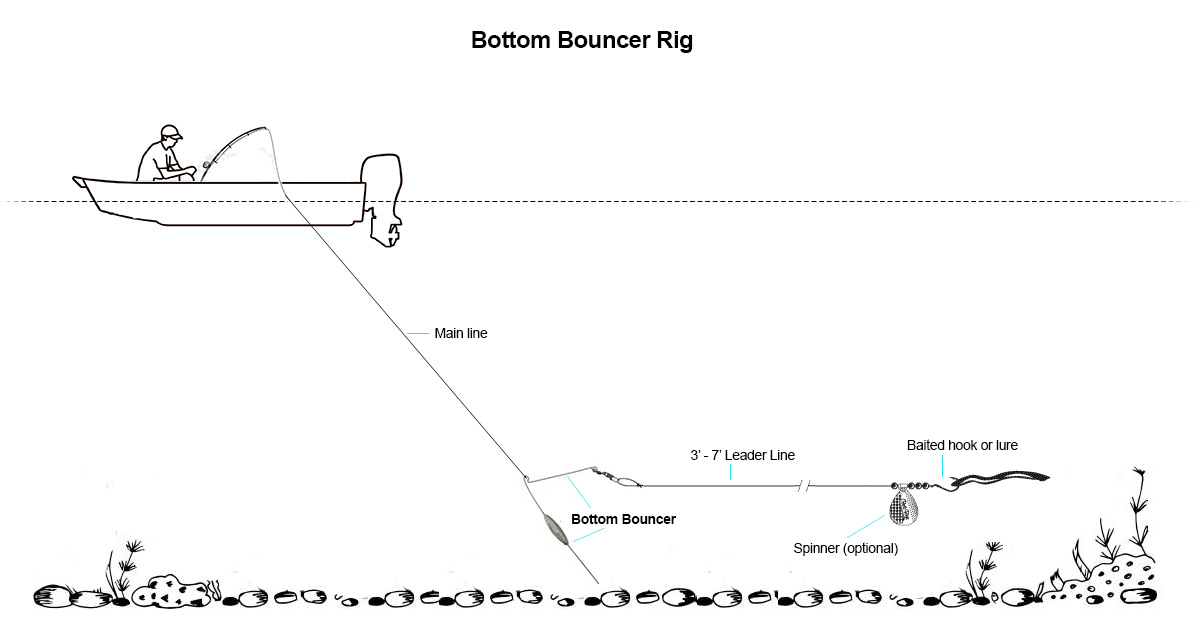Bottom bouncing is a form of fishing that is usually performed from a slow moving drift boat or motor boat. Bottom bounding involves dragging or bouncing your bait along the bottom of the water, stirring up tiny clouds of sand or mud in the process. These disturbances on the bottom attract predatory species from further away to take notice of your lure or bait, and strike.
Bottom bouncing requires careful consideration of the conditions above and below the water’s surface. Currents, wind, and tides can drastically affect the drift of your baits and boat. Muddy or sandy bottom conditions are perfect for bottom bouncing and allow you to cover a lot of water with little effort. It’s best to avoid bottom bouncing over heavy vegetation or structures where snags may cause your hook to get hung up.
Bottom Bouncing Methods
The most efficient way to bottom bounce is from a boat or vessel which drifts with the current. Although less efficient, bottom bouncing can also be performed from shore or fixed platforms. When bottom fishing from a fixed platform, you have two options: Bottom bounce with current or without current.
When bottom bouncing from a boat on rivers with current, keeping oars, a trolling motor, or your main motor running as you drift to maneuver around possible obstacles quickly is a best practice.
On lakes or areas of water without current, trolling motors and paddles can be used to create movement and simulate the effect of wind or current.
General guidelines for bottom bouncing:
- From a Boat: Keep baits and lures around a 60-degree angle in relation to the boat as your drift over a flat or sandbar. If fishing over heavy structures, keep the line at a tighter angle, closer to 90 degrees, to avoid dragging your line and bait into snags and hang-ups.
- With too much current or wind: If the current is moving too fast, you can deploy a smooth drag anchor to slow your speed. If there is too much wind, a drag net, or an empty five-gallon bucket tied to a rope should add enough drag to slow the vessel down.
- From a fixed platform with current: Keep moderate tension on the line and slowly feed the line to the bait or lure as it drags across the bottom away from you. This method is limited by how much line is on your reel.
- From a fixed platform without current: This method involves slowly retrieving your bait or lure after a cast and bouncing along the bottom slowly.
Baits, Lures and Rigs for Bottom Bouncing
The best baits to use when bottom bouncing will vary based on water conditions and target game fish species. Bucktails, jigs, spinners, and live baits are popular options for bottom bouncing. Bottom bouncing with live bait can present distress signals that will attractive bites from predatory fish. Dead bait provides the added attractions of scent.
Traditional baits presentations for bottom bouncing include the Carolina or Knocker rig. One of the most popular bottom bouncing presentations is the bottom bouncer rig which is created using a 1, 2 or 3 ounce bottom bouncer.
A bottom bouncer an “L” shaped wire attached to a weight and a safety-pin like clip called a snap swivel. The “L” shaped design of the bottom bouncer rig keeps the bait near the bottom and moving at a chosen depth, while reducing snaps in weeds, vegetation and other structure. The depth to which the lure will fall depends on the weight of the bottom bouncer. A 1oz bottom bouncer rig will fish down to approximately 15 feet of water and a 2oz from 15 to 25 feet. A 3oz bottom bouncer rig is used at depths of 25 to 40 feet deep.
The bottom bouncer rig is frequently used when bottom bouncing for Walleye.

Bottom Bouncing Tackle
- Both conventional and spinning tackle can be used for bottom bouncing. When bottom bouncing in deep water or using weight heavier than 1oz, we recommend using conventional (lever-wind) tackle with larger line capacities.
- Bottom bouncing fishing rods should be shorter when fishing from a boat and longer when fishing from shore or a fixed platform. The additional length will improve casting distances and help keep the line off the bottom.
- Monofilament, fluorocarbon and braided lines are appropriate for bottom bouncing. Monofilament lines are abrasion resistant and more elastic than fluorocarbon or braided lines and are therefore preferred when bouncing baits along the bottom.
Tips for Bottom Bouncing
- Occasionally check baits and lures to clear debris or plant material from line and baits
- Properly weighting your baits and lures will improve bite sensitivity and cause fewer hang-ups on the bottom.
- Use a drag net or smooth anchor to slow your drift when fishing in heavy wind or current.
- Bottom fishing is one of the easiest methods of fishing, and an effective way to attract bigger catches with minimal efforts, no matter the time or season.



